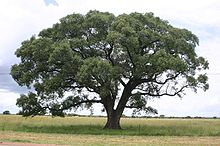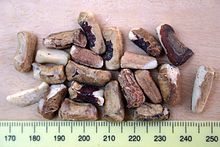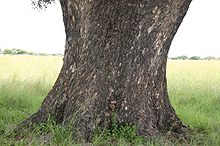- Sclerocarya birrea
-
Marula 
Scientific classification Kingdom: Plantae (unranked): Angiosperms (unranked): Eudicots (unranked): Rosids Order: Sapindales Family: Anacardiaceae Genus: Sclerocarya Species: S. birrea Binomial name Sclerocarya birrea
(A. Rich.) Hochst.The Marula (Sclerocarya birrea) (Greek σκληρός, sklērós, "hard", and κάρυον, káryon, "nut", in reference to the stone inside the fleshy fruit) is a medium-sized dioecious tree, indigenous to the miombo woodlands of Southern Africa and the Sudano-Sahelian range of West Africa. The tree is a single stemmed tree with a wide spreading crown. It is characterised by a grey mottled bark. The tree grows up to 18m tall mostly in low altitudes and open woodlands. The fruits are used in the liqueur Amarula. The distribution of this species throughout Africa has followed the Bantu in their migrations, as it has been an important item in their diet since time immemorial.
When ripe, the fruits have a light yellow skin, with white flesh, rich in vitamin C – about 8 times the amount found in an orange – are succulent, tart with a strong and distinctive flavour.[1] Inside is a walnut-sized, thick-walled stone. These stones, when dry, expose the seeds by shedding 2 (sometimes 3) small circular plugs at one end. The seeds have a delicate nutty flavour and are much sought after, especially by small rodents who know to gnaw exactly where the plugs are located.
Relationships: Belongs to the same family Anacardiaceae as the mango, cashew, pistachio and sumac, and is closely related to the genus Poupartia from Madagascar.
Common names:
- English: jelly plum, cat thorn, morula, cider tree, marula, maroola nut/plum
- Afrikaans: maroela
- Portuguese (Mozambique): canhoeiro
- Hausa: dania
- Swahili: mng'ongo
- Shona: mutsomo, mukwakwa, mushomo, muganu, mupfura; [fruits] pfura; [tree] mufura, mafuna, marula
- Tswana: morula
- Ndebele iganu, ikanyi, umganu, umkano
- Swazi: [fruits] emaganu, [tree] umganu
Zulu: [fruits] amaganu, [seeds, tree] umganu
- Other: Boran (Kenya) - didissa ; Kamba (Kenya) - muua; Kwangali - ufuongo; Lovedu - marula; Maasai (Kenya) - ol-mangwai; Meru (Kenya) - mura; Pedi [fruits] - lerula, marula; Pedi [tree] - morula, merula; Pokot (Kenya) - oruluo; Ronga (Mozambique) - ncanhi; Sebei (Kenya) - katetalum; Shangaan - nkanyi, inkanyi; Diga (Kenya) - mngongo; Tonga: tsua, tsula, umganu; Tugen (Kenya) - tololokwo; Dinka (Sudan) - Gummel; Nuer (Sudan) - Kamel, Omel; Moru (Sudan) - Kyele; Luo (Kenya) Ong'ono.
Contents
Uses
A traditional food plant in Africa, this little-known fruit has potential to improve nutrition, boost food security, foster rural development and support sustainable landcare.[2]
Cooking
The seed kernels are high in protein and fat with a subtle nutty flavour and constitute an important emergency food. Fruits are commonly eaten fresh or used to prepare juice, jelly and alcoholic drink. Marula oil, made from the seed kernel, is a delicious additive to meals in Africa. It contains antioxidants and oleic acid.
Medicinal
The bark is used both as treatment and a prophylaxis for malaria. An infusion of the inner bark of the marula tree may be applied to scorpion stings and snake bites to alleviate pain. The leaves are chewed on to help indigestion and to treat heartburn. Marula oil, made from the seed kernel, can be used as a type of skin care oil.
Other
Products of the fruit and the tree are useful in crafts and agriculture. Gums exudates from the stem are mixed with water and soot to make ink by certain tribes in the region. The bark also yields a red-brown dye used in colouring traditional craft ware. The fruit infusion is used to bathe tick-infested livestock. The fruit is regarded as a potent insecticide.
Popular culture
The alcoholic distilled beverage (maroela mampoer) made from the fruit is referenced in the stories of the South African writer Herman Charles Bosman.
The marula fruit is also eaten by various animals in Southern Africa. In the movie Animals Are Beautiful People by Jamie Uys, released in 1974, some scenes portray elephants, warthogs and monkeys becoming intoxicated from eating fermented marula fruit. Later research showed that these scenes, at least in large animals were improbable and, in all probability, staged. Elephants would need a huge amount of fermented marulas to have any effect on them, and other animals prefer the ripe fruit. The amount of water drunk by elephants each day would also dilute the effect of the fruit to such an extent that they would not be affected by it.[3]
See also
References
- ^ Wickens, G. E.; Food and Agriculture Organization (1995). "Potential Edible Nuts". Edible Nuts. Non-Wood Forest Products. 5. Rome: Food and Agriculture Organization. ISBN 92-5-103748-5. OCLC 34529770. http://www.fao.org/docrep/V8929E/v8929e06.htm. Retrieved 2008-11-10.
- ^ National Research Council (2008-01-25). "Marula". Lost Crops of Africa: Volume III: Fruits. Lost Crops of Africa. 3. Washington, D.C.: National Academies Press. ISBN 978-0-309-10596-5. OCLC 34344933. http://books.nap.edu/openbook.php?record_id=11879&page=117. Retrieved 2008-07-17.
- ^ Morris, Steve; David Humphreys and Dan Reynolds (2006). "Myth, marula, and elephant: an assessment of voluntary ethanol intoxication of the African elephant (Loxodonta africana) following feeding on the fruit of the marula tree (Sclerocarya birrea)". Physiological and Biochemical Zoology 79 (2): 363–9. doi:10.1086/499983. PMID 16555195. http://www.journals.uchicago.edu/doi/abs/10.1086/499983?url_ver=Z39.88-2003&rfr_id=ori:rid:crossref.org&rfr_dat=cr_pub%3dncbi.nlm.nih.gov. Retrieved 2008-10-28.
External links
Categories:- Sclerocarya
- Flora of South Africa
- Trees of South Africa
- Protected Trees of South Africa
- Fruit
- Desert fruit
- Ornamental trees
- Drought-tolerant trees
- Drought-tolerant plants
- Edible nuts and seeds
Wikimedia Foundation. 2010.



